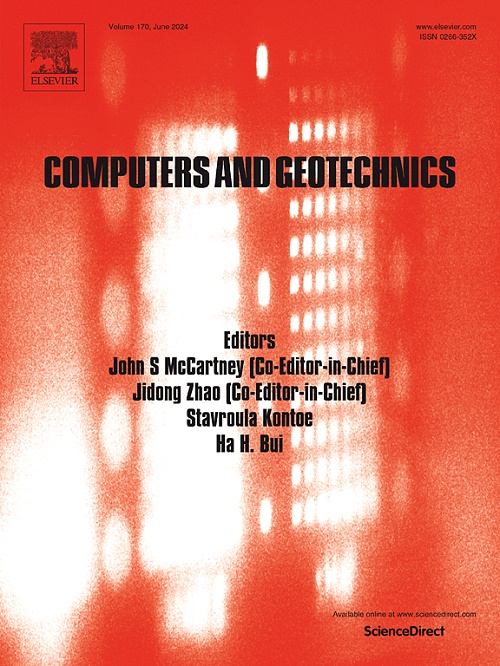支撑剂-裂隙岩石碰撞过程中应力、能量和裂纹扩展的DEM多尺度洞察
IF 5.3
1区 工程技术
Q1 COMPUTER SCIENCE, INTERDISCIPLINARY APPLICATIONS
引用次数: 0
摘要
本文在多尺度上研究了冲击剂(支撑剂模拟剂)在带有微裂缝的弱碎屑岩上的碰撞行为。基于离散元分析,采用线性平行键接触模型模拟岩石基底,采用Hertz-Mindlin接触模型捕捉颗粒块体接触之间的非线性力-位移关系。通过系统的参数研究,评估了微裂纹尺寸、数量、角度和位置对冲击器撞击基岩损伤潜力的影响。结果表明,其中一些参数对损伤潜势有显著影响,而另一些参数影响较小。通过比较宏观尺度上的应力和能量分布结果、中尺度上的穿透和接触地层信息以及微观尺度上的离散裂缝网络进行多尺度评价。这项研究的发现为支撑剂与碎屑岩的碰撞行为提供了重要的见解,特别是在水力压裂作业期间,并且可能有助于在更大范围内对这些系统进行建模。本文章由计算机程序翻译,如有差异,请以英文原文为准。
DEM multi-scale insights on the stress, energy and crack propagation in proppant-fractured rock collisions
The collision behavior of an impactor (proppant simulant) colliding on weak clastic rock with pre-existing microcracks is examined in this work at multi-scales. Using discrete element-based analysis, the linear parallel bond contact model is used to simulate the rock base, while the Hertz-Mindlin contact model is used to capture the non-linear force–displacement relationship between grain-block contacts. A systematic parametric study is conducted to assess the impact of microcrack size, number, angle, and position on the damage potential of the impactor colliding the base rock. The results indicate that some of these parameters significantly influence the damage potential while others have minimal effects. Multiscale assessment is conducted by comparing stress and energy distribution results at the macroscale, penetration and contact formation information at the mesoscale and studying the discrete fracture network at the microscale. The findings of this study provide important insights into the collision behavior of proppants with clastic rocks, particularly during hydraulic fracturing operations and can potentially aid in the modeling of these systems at larger scales.
求助全文
通过发布文献求助,成功后即可免费获取论文全文。
去求助
来源期刊

Computers and Geotechnics
地学-地球科学综合
CiteScore
9.10
自引率
15.10%
发文量
438
审稿时长
45 days
期刊介绍:
The use of computers is firmly established in geotechnical engineering and continues to grow rapidly in both engineering practice and academe. The development of advanced numerical techniques and constitutive modeling, in conjunction with rapid developments in computer hardware, enables problems to be tackled that were unthinkable even a few years ago. Computers and Geotechnics provides an up-to-date reference for engineers and researchers engaged in computer aided analysis and research in geotechnical engineering. The journal is intended for an expeditious dissemination of advanced computer applications across a broad range of geotechnical topics. Contributions on advances in numerical algorithms, computer implementation of new constitutive models and probabilistic methods are especially encouraged.
 求助内容:
求助内容: 应助结果提醒方式:
应助结果提醒方式:


